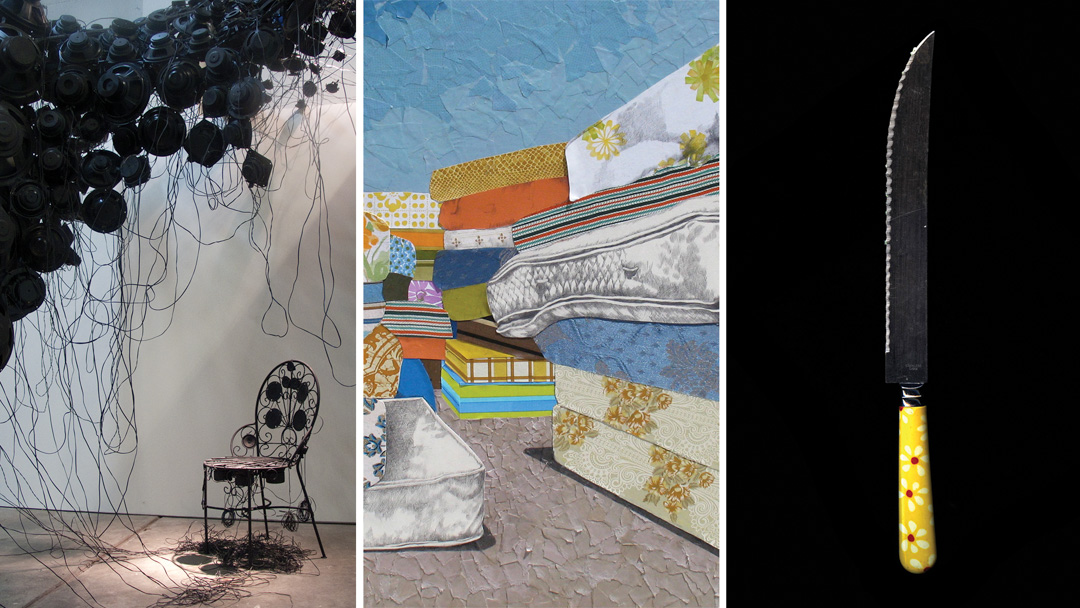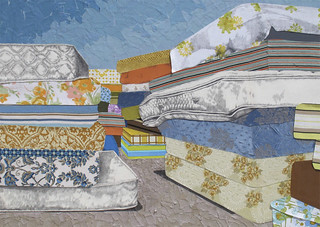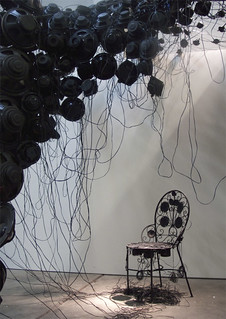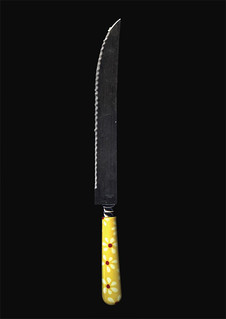
August 20, 2012
FOR IMMEDIATE RELEASE
When:
Reception-Friday, September 21, 2012, 5-9pm
Reception-Saturday, September 22, 2012, 1-5pm
Where:
Art Studio located at 503 Tunnel Ave.
Environmental Learning Center Gallery at 401 Tunnel Ave.
Admission is free and open to the public, all ages welcome, wheelchair accessible.
San Francisco, CA–The Artist in Residence Program at Recology San Francisco will host an exhibition and reception for current artists-in-residence Tamara Albaitis, Amy Wilson Faville, and student artist Calder Yates on Friday, September 21, from 5-9pm and Saturday, September 22, from 1-5pm. This exhibition will be the culmination of four months of work by the artists who have scavenged materials from the dump to make art and promote recycling and reuse.
A plant give-a-way will also take place beginning Friday on a first come basis. Plants have been rescued from the Public Disposal and Recycling Area and nursed back to life. Larger plants as well as propagated new starters will be available, one per visitor.
|
Though Albaitis actually sculpts sound through its placement, movement and repetition, her main physical sculptural medium is speaker cones and wire. She has found these in abundance at the dump and has gathered countless yards of speaker wire and hundreds of discarded home stereo speakers from which she’s extracted the raw cones. Albaitis has crafted a large-scale, cocoon-like form viewers/listeners are invited to enter for an immersive auditory experience, as well as smaller sound sculptures. Reflecting her background in painting and drawing Albaitis uses speaker wire to “draw” on walls, one of many ways she explores the physicality of sound. Other scavenged materials have been incorporated into her work, including fur and leather, appealing to Albaitis for their role as protective skins, and various personal items that have emotional associations. She has also been inspired for the first time to use the speaker boxes she normally discards, stacking them for a sonic cityscape. Audio is drawn from varied sources including a found collection of CDs capturing sounds from space, field recordings of the Recology facility, voice recordings from scavenged cassette and reel to reel tapes, and Albaitis’s own heartbeat. Explaining her sound installations Albaitis says, “Conceptually, these unfold as questions about sustainability (psychological and environmental), dependence, and the complex relationship between people and nature in a techno-centric culture.” A live performance with Delisa Myles (http://delisamyles.com) will take place during the exhibition receptions, Friday evening at 7:30pm and Saturday afternoon at 3pm. Albaitis received a BFA from the San Francisco Art Institute, and attended the International Institute of Art in Hangzhou, China where she studied Chinese landscape painting. In 2003 she was invited to establish the first experimental sound department at the School of the Art Institute of Chicago where she received the first MFA in sound art in the United States. She has been a recipient of a Eureka Fellowship and a James Irvine Fellowship and has exhibited nationally and internationally. |
 Amy Wilson Faville: Everything is Beautiful Amy Wilson Faville: Everything is BeautifulDuring her residency Amy Wilson Faville has continued with a body of work that explores discarded materials. Prior to her residency she was painting public dumping sites in her Oakland neighborhood, and while at Recology she has chosen to work in mixed-media collage, capitalizing on the wealth of items thrown away to make representations of discarded materials from discarded materials. Faville seeks to turn the tables on the refuse—creating something beautiful from the abject—while also posing larger questions about consumption and sustainability. Says Faville, “To me, trash contains both narrative and metaphor. Stories are implied by things that are discarded and abandoned; heaps of cast-off belongings symbolize our economic decline and societal malaise.” Faville’s working process first involves photographing her subject matter to create reference images for her paintings and collages. She discovered that photographing within the Public Disposal and Recycling Area (the dump) was challenging—objects moved through too rapidly as piles were quickly pushed by front loaders. However, individual piles of materials waiting to be recycled including mattresses, carpet, and damaged recycling and compost bins, sat longer for their photographs, so became the subject of her work. The resulting collage representations are rich with the repetition of form and line found in groupings of multiples. Faville’s titles for her pieces such as Mattress Canyon and Carpet Mountain speak both poetically to the enormity of the subject matter and ironically to its position as the antithesis of anything found in nature. Faville’s collages combine a range of found materials including 1970s-era wallpaper culled from sample books, colored file folders, fabrics (including mattress ticking cut from her subject matter), and her own drawings. Faville gravitates to the vivid colors and bold patterns prevalent in 60s and 70s textiles, so in her work the dreary and bedraggled become vibrant, as we are invited to take a slightly psychedelic journey through these representations of accumulated objects. Pieced together colors and patterns also suggest quiltmaking, the domestic, and related feelings of comfort and familiarity. Faville will also present an assemblage of collected materials as a three-dimensional collage immerging from a wall of her drawings and other two-dimensional work. Faville received an MFA and BFA from the San Francisco Art Institute. Her work has been exhibited at the San Jose Institute of Contemporary Art, and Rena Bransten Gallery in San Francisco, and is in the collections of the Achenbach Foundation for Graphic Arts at the Legion of Honor in San Francisco and the di Rosa Preserve in Napa. She is a faculty member at Diablo Valley College where she teaches drawing, painting, design, and color theory. |
|
Gesture and movement are important components of Yates’s work. Previous projects have been participatory, requiring the navigation of chance situations, and while at Recology he has involved facility workers in similar challenges. His choice of mundane objects speaks to their universality while also adding an element of the absurd. Yates addresses the desire to make things better and the sense of futility that often results from our limitations as humans. Explains Yates, “Specific experiences inform my approach. These include having lived in Florida and witnessing the aftermath of hurricanes and working as a teacher. There is a specific terror in recognizing that your attempts to ameliorate a situation would in fact lead to complicating the problem if not exacerbating the suffering altogether. And that’s what interests me.” Yates is a graduate student in the sculpture department at the California College of the Arts. He holds a BA in political science and studio art from the New College of Florida. He has exhibited at the Vermont Studio Center and was the APAC Artist in Residence at the Douglas Anderson School of the Arts in Jacksonville, Florida. Yates’s work will be on view at the Recology Environmental Learning Center at 401 Tunnel Avenue. |
| The Artist in Residence Program at Recology San Francisco is a one-of-a-kind program established in 1990 to encourage the conservation of natural resources and instill a greater appreciation for the environment and art in children and adults. Artists work for four months in studio space on site, use materials recovered from the Public Disposal and Recycling Area, and speak to students and the general public. Over ninety-five professional Bay Area artists have completed residencies. Applications are accepted annually in August. |
 Tamara Albaitis: Dwell
Tamara Albaitis: Dwell Calder Yates: Corpus Curare
Calder Yates: Corpus Curare